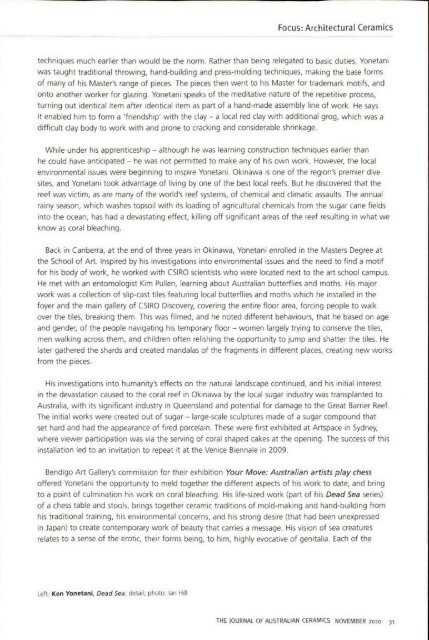The Journal of Australian Ceramics Vol 49 No 3 November 2010
You also want an ePaper? Increase the reach of your titles
YUMPU automatically turns print PDFs into web optimized ePapers that Google loves.
Focus : Architectural <strong>Ceramics</strong><br />
Ken Yonetani, Dead Sea, <strong>2010</strong>, porcelain, glass, LED wave light, metal, table h.63cm; photo: Ian Hill<br />
East Meets West<br />
Karen Finch pr<strong>of</strong>iles artist Ken Yonetani<br />
Ceramic artists in the West have long looked to Japan for inspiration, drawn by the marriage <strong>of</strong><br />
philosophy and creative practice. Bernard Leach set a precedent in his travels and study <strong>of</strong> the Japanese<br />
way with clay that has been emulated by generations <strong>of</strong> Western potters in the ensuing years. Ken<br />
Yonetani comes to contemporary ceramics from that Japanese tradition, having trained with a Master,<br />
Toshio Kinjo, in Okinawa, prior to relocating and developing his practice in Australia.<br />
Yonetani, following the other Japanese tradition <strong>of</strong> career development, trained initially in economics<br />
and worked in Tokyo for three years at the foreign exchange market. Night classes in ceramics <strong>of</strong>fered<br />
him an opportunity to begin exploring his creative side, leading to him resigning from his job. He<br />
travelled to Australia in 1999 with his <strong>Australian</strong> wife (whom he had met in Tokyo), spending twelve<br />
months in Canberra and worked in various jobs to support himself. He was <strong>of</strong>fered the chance to audit<br />
the degree course in ceramics at the School <strong>of</strong> Art at the <strong>Australian</strong> National University; then his wife<br />
Julia was awarded a three-year scholarship to study history and politics in Okinawa Japan, leading to<br />
Yonetani searching for, and finding, a Master with whom to train in the Japanese tradition.<br />
A Japanese ceramics apprenticeship is unlike any Western apprenticeship, and would ordinarily<br />
mean years and years <strong>of</strong> menial tasks before the apprentice began to be able to learn to work the clay.<br />
However, Yonetani's Master is Okinawan and also had health issues, which required that Yonetani learn<br />
THE JOURNAL OF AUSTRALIAN CERAMICS NOVEMBER <strong>2010</strong> 29


















